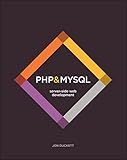Best PHP Programming Books to Buy in December 2025

PHP & MySQL: Server-side Web Development



Programming PHP: Creating Dynamic Web Pages



PHP Crash Course: The Complete, Modern, Hands-On Guide



Front-End Back-End Development with HTML, CSS, JavaScript, jQuery, PHP, and MySQL



Full Stack Web Development For Beginners: Learn Ecommerce Web Development Using HTML5, CSS3, Bootstrap, JavaScript, MySQL, and PHP



Learning PHP, MySQL & JavaScript: A Step-by-Step Guide to Creating Dynamic Websites (Learning PHP, MYSQL, Javascript, CSS & HTML5)


In Laravel, the "join" method is used to create SQL joins in your database queries. It allows you to combine data from multiple database tables based on a related column between them.
To use the "join" method in Laravel, you need to specify the table you want to join with and the column to join on. Here is an example of how to use the "join" method:
$users = DB::table('users') ->join('posts', 'users.id', '=', 'posts.user_id') ->select('users.name', 'posts.title') ->get();
In this example, we are joining the "users" table with the "posts" table based on the "id" column in the "users" table and the "user_id" column in the "posts" table. We are then selecting the "name" column from the "users" table and the "title" column from the "posts" table.
You can also specify different types of joins using the "join" method. For example, to perform a left join, you can use the "leftJoin" method instead:
$users = DB::table('users') ->leftJoin('posts', 'users.id', '=', 'posts.user_id') ->select('users.name', 'posts.title') ->get();
In this case, the "leftJoin" method performs a left join between the "users" and "posts" tables.
The "join" method in Laravel provides a powerful way to combine data from multiple database tables. It is useful when you need to fetch related data or when you want to filter data based on conditions in multiple tables.
What is the purpose of the "using" clause in the "join" method in Laravel?
The "using" clause in the "join" method in Laravel is used to specify the join column for the relationship. It is used when joining tables based on a specific column other than the default foreign key column.
By default, Laravel assumes that the column name used for the join is the primary key of the related table. However, using the "using" clause, you can explicitly specify the column to be used for the join. This can be useful when working with tables that have non-standard foreign key column names.
For example, consider the following code:
DB::table('users') ->join('orders', function ($join) { $join->on('users.id', '=', 'orders.user_id') ->using('orders.user_id'); }) ->get();
In this example, the "join" method is used to join the "users" table with the "orders" table. The "using" clause specifies that the join should be done using the "user_id" column of the "orders" table, instead of the default primary key column.
What is the difference between join and has in Laravel?
In Laravel, both the "join" and "has" methods are used to perform database queries and relationships, but they have different purposes and usage.
- Join: The "join" method is used to join two or more database tables together based on a related column. It is typically used to retrieve data from multiple tables by specifying the columns to be selected and the join conditions. Join methods available in Laravel include innerJoin, leftJoin, rightJoin, and crossJoin, which correspond to various types of joins in SQL. Example usage: DB::table('users') ->join('orders', 'users.id', '=', 'orders.user_id') ->select('users.*', 'orders.order_date') ->get();
- Has: The "has" method is used to check if a relationship exists between two models or query results. It is typically used to filter query results based on the existence (or non-existence) of related records. The "has" method can be appended to an Eloquent query builder to restrict the results based on the existence of a related model. Example usage: $users = User::has('orders')->get(); This query will retrieve all users who have at least one order.
In summary, "join" is used to combine tables and retrieve data from multiple tables, while "has" is used to filter query results based on the existence of a related model or record.
What is the syntax for using the "join" method in Laravel?
In Laravel, the join method is used to perform inner join on two tables. The syntax for using the join method is as follows:
$query = DB::table('table1') ->join('table2', 'table1.column', '=', 'table2.column') ->select('table1.column1', 'table2.column2', ...) ->get();
In this syntax:
- table1 and table2 are the names of the tables you want to join.
- 'table1.column' and 'table2.column' are the column names to join the tables on.
- select method is used to select the columns you want to retrieve from the joined tables. You can pass multiple column names as arguments or use an array to specify the columns.
- get method is used to execute the query and retrieve the results.
You can customize the join query based on your specific database schema and requirements.
How to join tables based on multiple conditions using the "join" method in Laravel?
To join tables based on multiple conditions using the "join" method in Laravel, you can use the "on" method multiple times to specify each condition. Here is an example:
DB::table('table1') ->join('table2', function($join) { $join->on('table1.column1', '=', 'table2.column1') ->on('table1.column2', '=', 'table2.column2'); }) ->select('table1.*', 'table2.column3') ->get();
In this example, we are joining "table1" and "table2" based on two conditions. The first condition is "table1.column1 = table2.column1" and the second condition is "table1.column2 = table2.column2".
You can add additional "on" conditions as needed to join tables based on more conditions.
